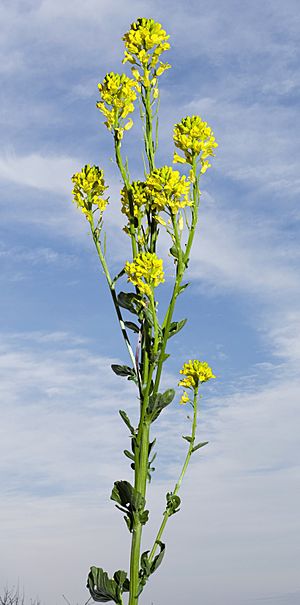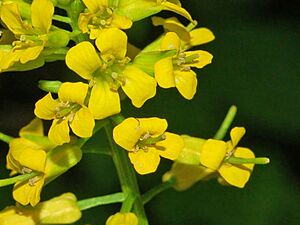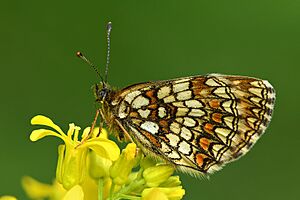Wintercress facts for kids
Quick facts for kids Wintercress |
|
|---|---|
 |
|
| Conservation status | |
| Scientific classification | |
| Genus: |
Barbarea
|
| Species: |
vulgaris
|
| Synonyms | |
|
|
Barbarea vulgaris, often called wintercress, is a common plant. It also has other names like herb barbara or yellow rocket. This plant is a type of herb that lives for two years. It belongs to the mustard family, called Brassicaceae.
Contents
What it Looks Like
This plant usually grows to be about 30 to 60 centimeters (1 to 2 feet) tall. Sometimes, it can even reach 1 meter (3 feet) high. Its stem has ridges and is smooth, with branches near the bottom.
The leaves at the base of the plant form a rosette. They are shiny and dark green. These bottom leaves have stalks and are shaped like a lyre, with a large main part and smaller parts below. The leaves higher up on the stem are smaller and have teeth or lobes.
The bright yellow flowers appear in spring. They grow in tight groups at the top of the plant. Each flower is about 7 to 9 millimeters long and has four petals. Wintercress blooms from April to July. After flowering, the plant produces pods that are about 15 to 30 millimeters long.
This plant contains natural chemicals like saponins and glucosinolates.
Plant History and Names
The plant Barbarea vulgaris was first officially described by William Aiton in 1812. Some people used to think another botanist, Robert Brown, was the first to describe it. However, Aiton was the one who published the description.
The most common name for this plant is 'wintercress'. This name can also be used for other plants in the Barbarea group. Other common names include 'cressy-greens' and 'yellow rocket'. Some names like 'bittercress' or 'upland cress' can be confusing because they are often used for different plants.
Why it's Called That
The name of the plant group, Barbarea, comes from Saint Barbara. She is known as the patron saint of artillerymen and miners. In the past, this plant was used to help heal wounds caused by explosions. The second part of the name, vulgaris, is Latin and means "common." This tells us it's a widely found plant.
How it Fights Insects Naturally
Most types of wintercress plants can naturally fight off certain insects. These insects usually feed on plants in the mustard family. For example, the diamondback moth (Plutella xylostella) and the flea beetle (Phyllotreta nemorum) are affected by wintercress.
The plant's resistance comes from chemicals called saponins. Female cabbage white butterflies, like Pieris rapae, are attracted to other chemicals in the plant, such as glucobarbarin. They lay their eggs on wintercress. However, the caterpillars of these butterflies grow well on the plant.
Diamondback moth females are also drawn to these chemicals and lay their eggs. But their larvae (baby insects) die soon after hatching because of the saponins. The adult moths don't seem to notice these harmful chemicals.
This special ability of wintercress has been used to control insects in farming. Farmers can plant wintercress in their fields. It acts as a "dead-end trap cropping" plant. It attracts diamondback moths to lay their eggs, but the larvae then die. This helps protect other crops like cabbage from these pests.
Where it Grows
Wintercress is originally from Eurasia (Europe and Asia) and North Africa. It has spread and now grows naturally in many parts of North America and New Zealand. In these places, it is often seen as a weed.
Its Range
You can find wintercress in temperate parts of North Africa, including Algeria and Tunisia. In Asia, it grows in countries like Afghanistan, China, Japan, India, and Turkey. It is also found in many countries across Europe, from Sweden in the north to Spain in the southwest.
Where it Lives
This plant likes places that are fresh or a bit wet. You can often find it along roadsides, near rivers, in fields, or in areas that are not used much. It can grow from sea level up to 2,500 meters (about 8,200 feet) high.
Wintercress can grow in different types of soil. It likes soils that are sandy, clay-like, or contain lime.
Uses
The young leaves of wintercress can be eaten raw or cooked. The flower buds and flowers are also safe to eat. As mentioned, it can also be used by farmers to trap and control diamondback moths, which are pests for plants like cabbage.
Types of Wintercress
There are several varieties of Barbarea vulgaris, including:
- Barbarea vulgaris var. arcuata
- Barbarea vulgaris var. brachycarpa
- Barbarea vulgaris var. longisiliquosa
- Barbarea vulgaris var. sylvestris
Gallery
See also
 In Spanish: Barbarea para niños
In Spanish: Barbarea para niños








